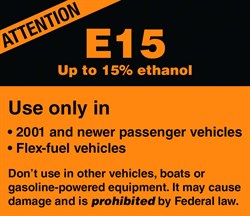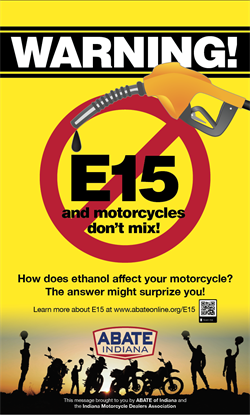The gas you buy at the pump this summer may become E15...
and THAT'S raising concerns
There’s a potential change coming this June to the fuels available at both local gas stations you know and those you visit while touring America this summer. Year-long sales of E15 may push fuels friendlier to motorcycles off the pumps at more gas stations and could cause more frequent misfuelling.
Currently, E15 gas is only available from mid-September to the end of May. Now, there’s a proposal to sell it in the summer. But before you put it in your tank, you need to know the concerns about E15 and the damage it could do to your bike.
What is E15?
You’re probably familiar with E10, a mixture of 90 percent pure gasoline and up to 10 percent ethanol that’s been commonly available at the pump for more than a decade. E15 blends up to 15 percent ethanol and 85 percent pure gasoline—a 50 percent increase in the ethanol content.
Ethanol blended into gasoline has primarily been limited to 10 percent due to problems with the volatility of higher blends contributing to smog during the hot summer months. As a result, the EPA restricts the sale of E15 for use in non-flex-fuel vehicles during the summer.
Renewable Fuel Standard
The Renewable Fuel Standard (RFS) was created by the Energy Policy Act of 2005 and expanded by the Energy Independence and Security Act of 2007. The RFS requires annually increasing the amount of biofuels that are blended into vehicle fuels—both gasoline and diesel. Boosting the year-round national blend limit to 15 percent would help meet that goal, but E15 has some problems in market expansion.
For retailers, the cost of retrofitting their pumps to comply with U.S. Environmental Protection Agency (EPA) regulations for selling E15 fuel, added to the expense of switching equipment and signage twice a year, has limited the market availability of E15. Removing the summer restriction opens the way for expanding E15 sales.
A problem for motorcycles
The motorcycle community has long understood that ethanol isn’t good for motorcycles. Ethanol can cause several problems:
• Reduced performance and mileage, since ethanol has one-third less energy than pure gasoline
• Absorption of water, further reducing fuel efficiency and potentially resulting in phase separation
• Increased engine and exhaust system temperature, since ethanol leans out the fuel/air mixture
• Corrosion of metal parts in the fuel system
• Damage to fuel lines and gaskets
The American Motorcyclist Association, Motorcycle Riders Foundation, and most motorcycle manufacturers oppose the expansion of E15 availability.
Inadvertent misfueling with E15 fuel is a significant concern. E15 use can void manufacturers’ warranties, and the EPA has acknowledged that E15 gas can damage engines. The EPA has also stated that E15 cannot be used in motorcycles.
In fact, a vast majority of motorcycles and ATVs in the United States today aren’t designed to run on ethanol blends higher than 10 percent. And many vintage machines have problems with any ethanol in the fuel.
Another concern is that the widespread adoption of E15 fuel could reduce the availability of E10 and even further reduce the availability of pure gasoline.
If the summer sale of E15 gas is enacted, use care to read all the small labels on blender pumps to avoid misfueling. And when selecting a fuel, be sure to know what your motorcycle manufacturer recommends.
The change to year-round E15 sales is still a proposal for the summer of 2019. You can make your opinion known to lawmakers and try to stop the implementation.

E15 Resources:
2018 Coalition Letter for H.R. 5855 Concerning Ethanol [MRF]
Confusion At The Gas Pump Could Be Costing Americans Dearly When It Comes to Outdoor Power Equipment [Outdoor Power Equipment Institute]
Federal legislation would require proper labeling of E15 fuel and consumer education campaign -- Contact your representative today to support H.R. 1024

